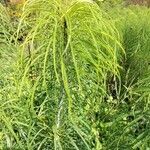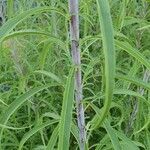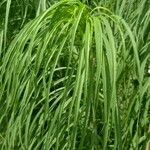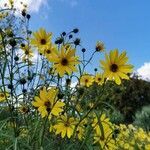Perennial with coarse roots and long stout rhizomes; stems 1.5–3 m, glabrous, sometimes glaucous; lvs numerous, commonly alternate except near the base, subglabrous or sparsely hairy, linear or nearly so, long-acuminate, to 20+ cm, seldom over 5(–10) mm wide, about the same color on both sides; disk red-purple (yellow), 1–2 cm wide; invol bracts loose, all subulate or lance-subulate, caudate, usually some of the inner exceeding the disk, glabrous or slightly hairy, often ciliolate; rays 10–20, 1.5–3 cm; 2n=34. Prairies and dry places, especially on calcareous substrate; Mo. to Kans. and Tex., and intr. into O. and n. Ill. Aug.–Oct. (H. orgyalis)





